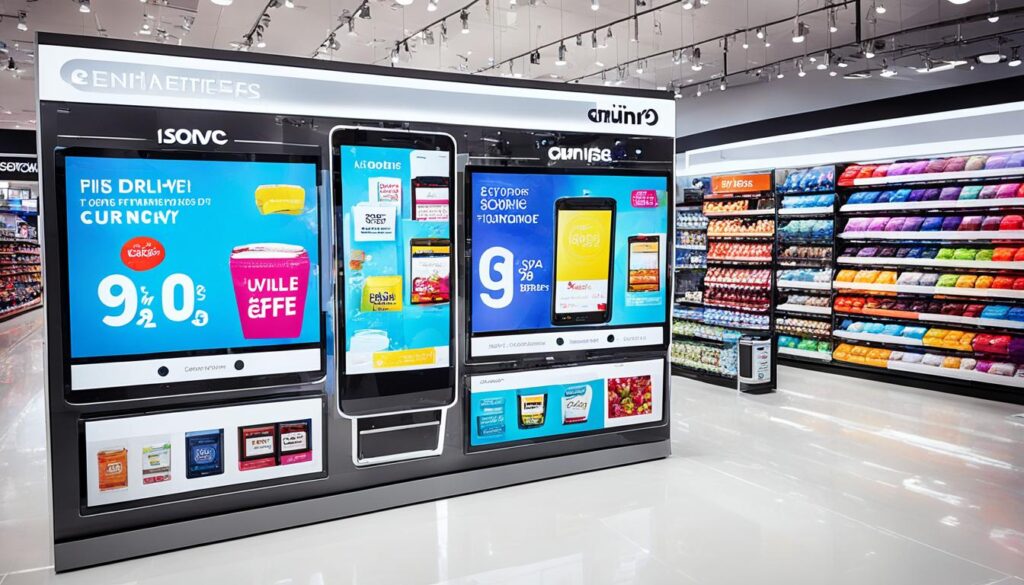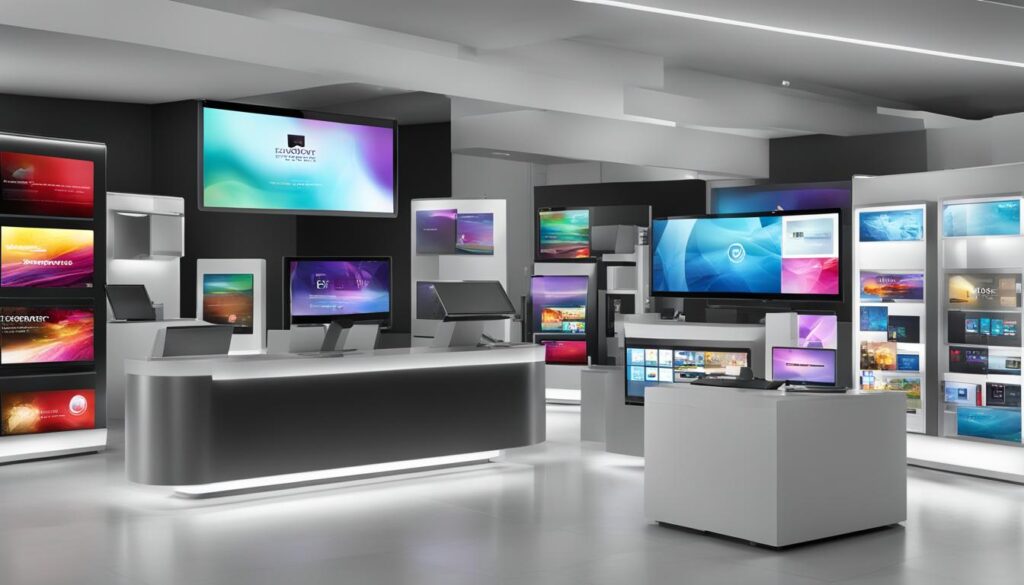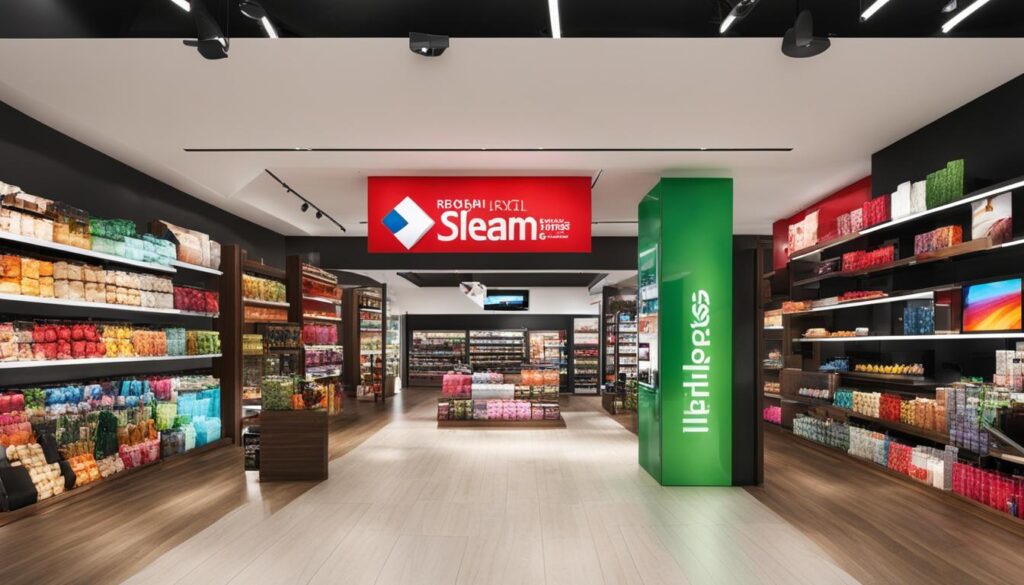Looking for an effective way to advertise your products and engage customers in your retail store? Look no further than digital signage software. With the right software solution, you can showcase your offerings, deliver targeted messages, and enhance the overall shopping experience for your customers.

Key Takeaways:
- Digital signage software is a powerful tool for retail stores to advertise services and display information.
- Top digital signage software options for retail stores include TelemetryTV, NoviSign, Yodeck, OnSign TV, and Viewneo.
- Benefits of digital signage software include visually appealing displays, interactive capabilities, and cloud-based management.
- Factors to consider when choosing digital signage software include specific needs, hardware compatibility, ease-of-use, and pricing.
- By utilizing the best digital signage software, retail stores can enhance the customer experience and drive success for their business.
Top Digital Signage Software for Retail
When it comes to finding the best digital signage software for retail, there are several top options that offer a range of features and capabilities. These software solutions are designed to help retailers effectively engage customers, promote products, and enhance the overall shopping experience. Here are some of the top digital signage software options for retail stores:
- TelemetryTV: TelemetryTV is a powerful digital signage platform that offers a user-friendly interface and a wide range of features. It allows retailers to create stunning visual displays, schedule playlists, and easily manage content across multiple locations. With cloud-based functionality, retailers can centrally control their digital signage system for retail stores, ensuring consistent branding and messaging.
- NoviSign: NoviSign is another popular choice for retail digital signage software. It offers an intuitive drag-and-drop editor, making it easy for retailers to create and customize captivating content. The software is compatible with various hardware devices, such as touchscreens and video walls, allowing for interactive digital signage experiences in stores.
- Yodeck: Yodeck is a cloud-based digital signage solution that offers simplicity and affordability. It enables retailers to remotely manage and update their digital displays, making it ideal for multi-location retail stores. With its user-friendly interface, retailers can easily create dynamic content and schedule playlists to engage customers and drive sales.
- OnSign TV: OnSign TV is a scalable digital signage software that provides powerful features for retail stores. It offers real-time monitoring and analytics, allowing retailers to track the performance of their digital displays and optimize content accordingly. The software is compatible with various operating systems, making it easily accessible for retailers.
- Viewneo: Viewneo is a comprehensive digital signage solution that caters to the needs of retail stores. It offers a wide range of templates and widgets, enabling retailers to create visually compelling displays. With its advanced scheduling capabilities, retailers can deliver targeted messages and promotions to specific audiences.
These top digital signage software options for retail provide retailers with the tools they need to effectively manage their digital displays and engage customers. Whether it’s creating visually stunning content, scheduling playlists, or remotely updating signage, these software solutions offer the features and functionalities required for successful in-store marketing efforts.
By leveraging the power of the best digital signage software, retail stores can enhance their brand presence, drive customer engagement, and ultimately increase sales.

Benefits of Digital Signage Software for Retail Stores
Retail stores can reap numerous benefits from implementing digital signage software. This technology enables retailers to create captivating displays that immediately grab the attention of customers and pique their interest in showcased products. By leveraging interactive digital signage, retailers can actively engage customers and deliver a more immersive and personalized shopping experience.
One of the key advantages of digital signage software is its cloud-based functionality. With cloud-based digital signage software, retailers can effortlessly manage and update content across multiple store locations. This ensures consistent branding and messaging, regardless of the geographical spread of a retailer’s stores.

Indoor digital signage is strategically placed throughout the store to guide customers, highlight special offers, and influence purchasing decisions. Whether it’s a vibrant display showcasing the latest fashion trends or an interactive kiosk providing product recommendations, indoor digital signage effectively captures customer attention and drives engagement.
Factors to Consider When Choosing Digital Signage Software for Retail
When selecting digital signage software for retail stores, it’s crucial to take several factors into consideration. The right software can greatly enhance the effectiveness of your retail digital display and interactive digital signage efforts. Here are some key considerations:
- Specific Needs and Goals: Evaluate your unique requirements and objectives. Determine the type of content you want to display, whether it’s promotional videos, product catalogs, social media feeds, or interactive touchscreens. Consider the level of interactivity you desire and whether you need scalability for future expansion.
- Hardware Compatibility: Ensure the software is compatible with various hardware devices commonly used in retail, such as touchscreens, video walls, or kiosks. This flexibility allows you to create different types of displays and engage customers effectively.
- User-Friendly Interface: Look for software that offers a user-friendly interface and ease of use. This ensures that you and your team can quickly and efficiently manage and update content without the need for extensive technical training.
- Customer Support and Training: Check for the availability of customer support and training resources provided by the software vendor. Having timely assistance and access to educational materials can help you maximize the potential of the software and troubleshoot any issues that may arise.
- Pricing and Licensing: Consider the cost of the software and the licensing structure. Compare different options to find the most suitable pricing model for your business. Some software providers offer subscription-based plans, while others may require upfront licensing fees.
- Integration Capabilities: Determine whether the software can integrate with other systems and software used in your retail operations. Seamless integration with inventory management, POS systems, or customer relationship management (CRM) software can streamline your processes and provide a smooth customer experience.
By thoroughly evaluating these factors, you can make an informed decision and select the best digital signage software for your retail store’s unique needs.
Conclusion
In conclusion, digital signage software is an indispensable solution for retail stores looking to enhance their customer experience and drive sales. By leveraging the best digital signage software options available, retailers can create visually stunning and captivating displays that effectively showcase their products and promotions. This allows them to engage customers, increase brand awareness, and ultimately boost their bottom line.
With the right digital signage software, retailers can provide a seamless and personalized shopping experience for their customers. They can easily create and schedule dynamic content, ensuring that the right message reaches the right audience at the right time. Whether it’s highlighting new arrivals, promoting limited-time offers, or providing interactive product information, digital signage software empowers retailers to effectively communicate with their customers in a captivating way.
Moreover, digital signage software offers scalability and flexibility for retail stores. As businesses grow and expand, the software can easily adapt to accommodate new locations and displays. This enables retailers to maintain a consistent brand image and messaging across multiple stores, enhancing their overall brand presence and customer perception.
In today’s rapidly evolving retail industry, staying competitive is paramount. The implementation of the best digital signage software provides retail stores with a competitive advantage by enabling them to leverage technology to create immersive and impactful experiences for their customers. By investing in the right digital signage solution, retailers can future-proof their business, drive success, and solidify their position as leaders in the retail space.
FAQ
What is digital signage software?
Digital signage software is a tool that allows retail stores to create, manage, and display digital content on screens throughout their location. It enables retailers to showcase products, promotions, and information in an engaging and visually appealing way.
How can digital signage software benefit retail stores?
Digital signage software provides several benefits for retail stores. It allows retailers to create attractive displays that capture customer attention and generate interest in their products. With interactive capabilities, retailers can engage customers and provide a more personalized shopping experience. Cloud-based functionality enables easy management and updates of content across multiple store locations, ensuring consistent branding and messaging.
What are the top digital signage software options for retail stores?
Some of the top digital signage software options for retail stores include TelemetryTV, NoviSign, Yodeck, OnSign TV, and Viewneo. These software solutions offer affordability, ease-of-use, cloud-based functionality, and compatibility with various operating systems.
What factors should retailers consider when choosing digital signage software?
Retailers should consider their specific needs and goals, such as the type of content they want to display, the level of interactivity required, and the scalability of the software for future growth. Compatibility with different hardware devices, such as touchscreens and video walls, should be considered. User interface, customer support and training resources, pricing and licensing options, and integration capabilities with other software and systems are also important factors to consider.